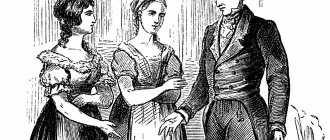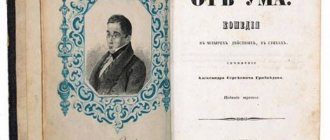- Essays
- On literature
- Griboyedov
- The history of the comedy Woe from Wit
The comedy play “Woe from Wit” became a real outstanding achievement of Alexander Sergeevich Griboyedov, an original classic of Russian literature of the first half of the 19th century. The creation of the comedy began in 1821, when Griboyedov was in military service in Tiflis under General A.P. Ermolov. Upon returning to his native Moscow, Alexander Sergeevich continued working on a dramatic comedy. Even far before the official publication, the local reading society was already able to obtain the first copies of the play, which in those days were called “lists,” that is, what was copied from the original. The Moscow Reading Society received the first copies of the author's manuscript towards the end of 1824.
The first publication of the comedy play, unfortunately, was after the death of Griboyedov. The censorship delayed for a very long time the decision to officially release it. The widow of the author A. Griboedov, together with his sister, even submitted several petitions for publication, which were also postponed for consideration.
Some time later, in 1833, the Tsar, at the request of Minister Uvarov, gave permission to print the comedy, and a few weeks later Alexander Sergeevich’s play “Woe from Wit” was first published in a separate edition in Semyon’s printing house at the Imperial Academy. 6 years later, in 1839, the reading society saw the second edition, St. Petersburg, with corrections and censorship.
Griboyedov tried several times during his life to stage a comedy play, but each of them was never successful. The premiere of the play was staged in 1831 in St. Petersburg after the author’s life.
After the official publication of “Woe from Wit,” its demand was an order of magnitude greater than the number of editions. A printed book was quite difficult to acquire, not because of its cost, but in limited quantities, so the printing society began to make its own copies. The most interesting thing is that in these “lists”, society retained all the so-called “forbidden” words and places that were corrected by censorship.
The complete edition of the comedy could only be published in 1862, in its present, original form, by order of Emperor Alexander II. It is this version of the publication that is known to today's reading society and similar circles. The original edition, that is, Griboyedov’s original manuscript, was never discovered. The comedy came to us only in the form of a certain list.
Option 2
The history of the creation of Griboedov's comedy Woe from Wit: concept, production, publication
Griboyedov's work "Woe from Wit" was published in 1824 and is a comedy play that describes society during serfdom and covers the time period from 1808 to 1824. The comedy describes the problems of society of that time, as well as the theme of love. The love story is well revealed in the description of the lives of the main characters. The heroes of the love triangle are Andrei Chatsky, Sofya Famusova and Alexey Molchalin.
Andrey Chatsky is an intelligent, active young man who strives for development and improvement. At the same time, Andrey is a pronounced romantic. He is gentle, delicate, tactful. Chatsky is in love with Sophia. He saw only positive qualities in her, despite the complex character and eccentric nature of the young girl. Andrei Chatsky is an ideal candidate for Sofia Famusova, but the girl’s heart belongs to someone else.
Sofya Famusova is a bright representative of young ladies of that era. Sophia is a rich lady who languishes from idleness and boredom in her father's house. She is smart, educated, but because of her youth, in the story she is only 17 years old, she is naive and inexperienced. Due to inexperience, her choice falls not on the smart and modest Chatsky, but on the narrow-minded Molchalin.
Alexey Molchalin was stupid and did not strive for self-development. The main life goal of the hero is to achieve his own well-being. Therefore, it is beneficial for him to communicate with Sophia in order to enter Famusov Sr.’s social circle. His behavior towards Sophia is false and feigned.
Sofya, in love, does not notice Alexei’s shortcomings, perceiving them as an advantage. However, Sophia fails to connect her life with Molchalin. Alexei's choice falls on the young lady Lisa. Famusov expels Molchalin from the house. Sophia is having a hard time experiencing the loss of her loved one. She is morally broken and oppressed. Andrei is disappointed in Famusov’s daughter and stops communicating with her. Sophia is left completely alone. The real victim of the love triangle is Andrei Chatsky. He is disappointed in society and in life in general. The reason for this disappointment is his romantic nature and the fact that he always puts sincere feelings in the foreground, and not personal gain and career growth, as Molchalin does.
The main goal of the work is the author’s desire to show that most representatives of the era do not need, and are even alien to, real, sincere love. And those who have these qualities become redundant in the so-called “Famusov society.”
Features of various editions
In Tiflis in 1820, 2 acts of the play were written. There are few differences from the final text. The essence of the plan has not changed. Accusatory satire and demonstration of the vices of society. At the estate of S.N. Begichev, Griboyedov wrote Acts 3 and 4, but at that time he did not consider that work on the text was completed. The play has undergone changes:
- the name “Woe to Wit” has a different meaning: “Woe from Wit”;
- the root of the main character's surname Chadsky (chad) became Chatsky;
- monologue of the main character in the first act;
- dialogue between the maid and Sophia;
- dream of the master's daughter.
The text changed, becoming more and more saturated with phrases that became catchphrases. There are edits by A. Pushkin and V. Bulgarin.
It is interesting that some dialogues remained base immediately after the first edition, for example, the monologue “Who are the judges?”
Manuscripts changed depending on the audience for which they were read. They tried to soften the author’s harsh judgments, thereby violating their meaning. But it was not possible to change the essence of the play. She was compared to a bomb that blew up the minds of an entire generation.
Concept, production and publication
Alexander Sergeevich Griboyedov dedicated his famous work to the divided nobility. The comedy satirizes the secular society that existed in the first half of the nineteenth century.
The idea of writing a play came to Griboedov in 1816 after his arrival in St. Petersburg. Finding himself at a social reception, Alexander Sergeevich was indignant at the passion of Russian people for foreign things. Having witnessed how guests at the evening bowed to a foreigner, Griboedov reacted very angrily to what was happening. Someone even suggested that the writer had gone crazy. These rumors began to spread quickly, and ultimately gave Alexander Sergeevich an idea for a work exposing the vices of the society that existed at that time. It turns out that the prototype of Chatsky, the protagonist of the play, was the playwright himself. While attending various events, the poet observed a lot of people, and subsequently some characters were reflected in “Woe from Wit.” The writer began to read his work in the year one thousand eight hundred and twenty-three in Moscow, and work on the work ended only in the twenty-fourth year near Tiflis. The comedy was originally called "Woe to Wit." Due to censorship, the play underwent frequent changes. For a long time, the comedy was only in handwritten form. In the year 25 of the nineteenth century, small fragments of “Woe from Wit” were published in the almanac “Russian Waist”.
Hoping for help in publishing the work, Griboyedov, before leaving for Persia, gives the manuscript to comrade Fadey Venediktovich Bulgarin. Only after the death of the author, in 1833, the play was published. Previously, only excerpts were published, and theater productions were greatly distorted by censorship. Without the intervention of censors, the comedy was published in Moscow in 1875.
The hero of the play, Chatsky, has a lot in common with the history of the creation of the work. He was helpless in the fight against the foundations of the society in which he had to find himself. Chatsky did not convince the nobility of the need for changes. In the same way, Griboyedov did not achieve fundamental changes in the old society with his revealing comedy. However, "Woe from Wit" resonated with a new generation of secular people.
The work overcame all the challenges that arose during publication, and, thanks to the lightness of the style, it quickly spread into citations. Griboyedov managed to write a comedy that is still relevant today, because the clash of opposing views is an integral part of society.
Literature lesson summary “A. S. Griboyedov. The history of the creation of "Woe from Wit".
Literature 9th grade. 10/24/16
Topic: "A. S. Griboyedov. The history of the creation of "Woe from Wit".
Target:
trace the history of comedy; get acquainted with the gallery of images of the play; analyze how love and social conflicts arise in comedy.
During the classes:
- Org. moment
- Checking d / z
— Student survey
— Individual worker with weak students (cards)
New topic
1) Introductory speech by the teacher.
Today we begin our acquaintance with the wonderful, magnificent in concept and execution of A.S. Griboyedov’s work “Woe from Wit”. This play belongs to a number of works “for all times”. For almost two hundred years it has been a constant in the repertoires of various theaters. Why? How does it attract the viewer and reader? Why has none of the critics yet given a complete and complete analysis of this work? These and other questions will confront us throughout several lessons in studying the immortal comedy.
Well, good luck?!
2) Theory of literature.
— Do you remember how dramatic works differ from other genres? (from lyrics and epic)?
(They are intended to be performed on stage)
—What is the content of a dramatic work?
(The content consists of the characters’ remarks in the form of dialogue and monologue. The characters’ remarks are accompanied by stage directions and acting. The stage setting (scenery, costumes, music) enhances the impression of the performance.
— What are dialogue and monologue? Remarque?
— Name the types of drama.
(Tragedy, drama, comedy)
— What are the hallmarks of comedy?
(Comedy ridicules certain aspects of social life, negative traits and characteristics of people’s characters)
Dramatic works differ from lyrics and epics primarily in that they are intended to be performed on stage. Their content consists of speeches, conversations of characters in the form of dialogue and monologue. The speeches of the characters are accompanied by remarks, i.e. author's instructions about the setting of the action, the internal state of the characters, their facial expressions and gestures.
Teacher.
Griboyedov created a comedy. What aspects of social life, the negative traits and characteristics of people’s characters are ridiculed in it, we learn in the course of analyzing the work, but what is the history of its creation.
3) The history of the creation of the comedy "Woe from Wit".
The comedy was conceived in St. Petersburg around 1816. Griboyedov, returning from abroad, found himself at one of the social evenings and was amazed at how the entire public servilely before everything foreign. That evening she showered attention and care on a talkative Frenchman. Griboyedov could not stand it and made a fiery accusatory speech. While he was speaking, someone from the audience declared that Griboyedov was crazy and thus spread the rumor throughout St. Petersburg. Griboedov, in order to take revenge on secular society, decided to write a comedy on this occasion.
There is also a version that Griboyedov dreamed about the plot of the comedy. Moreover, the author himself confirms it in one of his letters: “When should it be ready? “In a year, take an oath... And I gave it with trepidation... I woke up... the cold of the night dispelled my unconsciousness, I sat down to write and vividly remember my promise: IN A DREAM IT WILL BE FULFILLED!”
The comedy was completed by the autumn of 1824. Griboyedov really wanted to see the comedy... The comedy produced an indescribable effect... Only after the death of the author did the comedy appear on the professional stage. The first separate edition of “Woe from Wit” was published in Moscow in 1833. The original title of the comedy was “Woe to Wit.” Then the author changes it to “Woe from Wit.”
4) Gallery of images of the play.
- Name the characters in the comedy.
One of the characteristic features of this play is the “talking names”.
FAMUSOV (from Latin Fama - “rumour”). His dependence on public opinion and rumors is emphasized by his “speaking surname.”
MOLCHALIN - he is timid and silent with Sophia and Famusov, but with Lisa and Chatsky he turns into a “talker”. Obviously, his surname carries a hint of hidden and important properties of nature.
CHATSKY - carries a hint of the name of the most interesting person of that era: Pyotr Yakovlevich Chaadaev. His views, ideals, beliefs - in a word, all his worldviews turned out to be unacceptable for Tsarist Russia, so he suffered an unprecedented and terrible punishment. By the highest (imperial) decree he was declared crazy. It so happened that the literary character did not repeat the fate of his prototype, but predicted it.
Sofya, Famusov and Molchalin. Famusov and Chatsky. Skalozub.
Famusov, Chatsky and Skalozub.
The beginning of love and social conflicts in comedy.
The plot of the play is based on a dramatic conflict.
—What is the conflict of a dramatic work?
(acute contradiction, clash of opposing views, worldviews)
Teacher. Conflict is the main spring, the source of tension in a literary work, ensuring the development of the plot.
Conversation with students:
- Why is Sophia confused?
(She wasn’t expecting Chatsky. During the three years of his absence, she became interested in something else)
— What does Chatsky remember from childhood?
(games, children's pranks with Sophia in Famusov's house)
- What hurt Sophia? What is the origin of a love conflict?
(I was touched by ridicule of Molchalin. A love triangle was formed: Chatsky - Sophia - Molchalin)
Kurtag is a reception day at court.
Toupey - a hairstyle in the form of a downed crest.
—Who does Famusov use as an example?
- Can Famusov and Chatsky find a common language?
(No. They have opposite views on service, education, upbringing, etc. Therefore, a contradiction arises between them, and therefore a conflict)
4. Reflection.
- Today in class I learned...
-Today in class I realized...
- I would like to find out in the next lesson...
5.
Homework
1) Read acts 1 and 2 of the comedy.
Mother's House: Primary Education
Novinsky Boulevard, 17
Alexander Griboedov spent his childhood and youth in the house of his mother Anastasia Fedorovna (nee also Griboyedova), a representative of a famous noble family. She inherited the estate on Novinsky Boulevard from her brother, Alexei Griboedov.
The future author of “Woe from Wit” was educated at home. Particular attention was paid to foreign languages: as a child he learned French, English, German and Italian. He was taught by the best teachers, among whom was Bogdan Ion, a graduate of the University of Göttingen.
In 1812, Griboyedov volunteered for the Moscow Hussar Regiment. He went to war straight from home - that was the last time he saw him; that same year the estate was badly damaged by a fire.
Another house was built on this site, which the writer immediately disliked. After Griboyedov’s death, his mother sold the mansion, and the new owners rebuilt it more than once. Today on this site there is a building erected in the 1970s.




